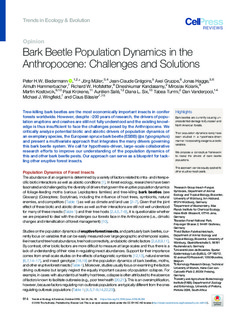| dc.contributor.author | Biedermann, Peter H.W. | |
| dc.contributor.author | Müller, Jörg | |
| dc.contributor.author | Grégoire, Jean-Claude | |
| dc.contributor.author | Gruppe, Axel | |
| dc.contributor.author | Hagge, Jonas | |
| dc.contributor.author | Hammerbacher, Almuth | |
| dc.contributor.author | Hofstetter, Richard W. | |
| dc.contributor.author | Kandasamy, Dineshkumar | |
| dc.contributor.author | Kolarik, Miroslav | |
| dc.contributor.author | Kostovcik, Martin | |
| dc.contributor.author | Krokene, Paal | |
| dc.contributor.author | Sallé, Aurélien | |
| dc.contributor.author | Six, Diana L. | |
| dc.contributor.author | Turrini, Tabea | |
| dc.contributor.author | Vanderpool, Dan | |
| dc.contributor.author | Wingfield, Michael J. | |
| dc.contributor.author | Bässler, Claus | |
| dc.date.accessioned | 2019-10-14T13:19:44Z | |
| dc.date.available | 2019-10-14T13:19:44Z | |
| dc.date.created | 2019-08-30T12:24:14Z | |
| dc.date.issued | 2019 | |
| dc.identifier.citation | Trends in Ecology & Evolution. 2019, . | nb_NO |
| dc.identifier.issn | 0169-5347 | |
| dc.identifier.uri | http://hdl.handle.net/11250/2622047 | |
| dc.description.abstract | Tree-killing bark beetles are the most economically important insects in conifer forests worldwide. However, despite >200 years of research, the drivers of population eruptions and crashes are still not fully understood and the existing knowledge is thus insufficient to face the challenges posed by the Anthropocene. We critically analyze potential biotic and abiotic drivers of population dynamics of an exemplary species, the European spruce bark beetle (ESBB) (Ips typographus) and present a multivariate approach that integrates the many drivers governing this bark beetle system. We call for hypothesis-driven, large-scale collaborative research efforts to improve our understanding of the population dynamics of this and other bark beetle pests. Our approach can serve as a blueprint for tackling other eruptive forest insects. | nb_NO |
| dc.language.iso | eng | nb_NO |
| dc.rights | Attribution-NonCommercial-NoDerivatives 4.0 Internasjonal | * |
| dc.rights.uri | http://creativecommons.org/licenses/by-nc-nd/4.0/deed.no | * |
| dc.subject | Bark beetle | nb_NO |
| dc.subject | Global change | nb_NO |
| dc.subject | Symbiosis | nb_NO |
| dc.subject | Population dynamics | nb_NO |
| dc.subject | Biotic interactions | nb_NO |
| dc.subject | Forest insect pest | nb_NO |
| dc.title | Bark Beetle Population Dynamics in the Anthropocene: Challenges and Solutions | nb_NO |
| dc.type | Journal article | nb_NO |
| dc.type | Peer reviewed | nb_NO |
| dc.description.version | publishedVersion | nb_NO |
| dc.rights.holder | © 2019 The Author(s). | nb_NO |
| dc.subject.nsi | VDP::Landbruks- og Fiskerifag: 900::Landbruksfag: 910::Skogbruk: 915 | nb_NO |
| dc.subject.nsi | VDP::Landbruks- og Fiskerifag: 900::Landbruksfag: 910 | nb_NO |
| dc.source.pagenumber | 11 | nb_NO |
| dc.source.journal | Trends in Ecology & Evolution | nb_NO |
| dc.identifier.doi | 10.1016/j.tree.2019.06.002 | |
| dc.identifier.cristin | 1720073 | |
| dc.relation.project | Andre: 626279 - Marie Curie Intra-European Fellowship (IEF) | nb_NO |
| dc.relation.project | Andre: BI 1956/1-1 - German Research Foundation (DFG) | nb_NO |
| dc.relation.project | Norges forskningsråd: 249958 | nb_NO |
| cristin.unitcode | 7677,3,0,0 | |
| cristin.unitname | Divisjon for bioteknologi og plantehelse | |
| cristin.ispublished | true | |
| cristin.fulltext | original | |
| cristin.qualitycode | 1 | |

